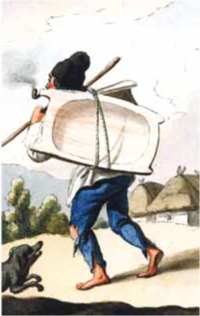Boyash
You can help expand this article with text translated from the corresponding article in Romanian. (January 2023) Click [show] for important translation instructions.
|
This article needs additional citations for verification. (October 2022) |
| Total population | |
|---|---|
| ≈ 14,000[1] |
| Part of a series on |
| Romani people |
|---|
|
Romani people by sub-group |
|
Romani diaspora by country
|
Boyash or Bayash (
History
This section needs additional citations for verification. (January 2023) |
The Boyash or Băieși (in Romanian) are a branch/
At the end of the 16th century the Boyash started migrating towards the south, in Wallachia, and the east, in Moldavia, where they were held as slaves together with other Romani groups (until the slavery was abolished in 1855–56).[4][page needed]
Another name for the Boyash, Rudari, comes from the
Population

After the liberation of the Roma from slavery (by the middle of the 19th century), many
In 1993, about 14,000 of the 280,000 recorded Hungarian Roma were Boyash.[6]
In
Names in other languages
In English, the commonly accepted name for the ethnic group is Boyash, however in contemporary Bulgaria the terms Ludari and Rudari are in common use, while in Romania both terms are present in some form: Rudari and Băieși.[10]
For the same ethnic group in
They are also known by many appellations based on trades; in addition to Rudari/Ludari ("miners", from Serbian and Bulgarian ruda "ore, metal") they are known as Kopanari ("cradle-makers", from Serbian and Bulgarian kopanja "wooden box"), Koritari ("trough-makers"), Lingurara ("spoon-makers", cf. Romanian lingură "spoon") and Ursari (cf. Romanian urs "bear") or Mechkara ("bear-trainers").[14]
Education
Education in the Romanian language is available only for the Banyash living in Romanian villages in the Serbian Banat, as well as in Hungary, in the subdialect of the Romanian language spoken by Boyash communities in (central and western) Hungary.[15]
During the last few years there have been several attempts on behalf of local non-governmental organizations in East Bačka region to introduce optional classes in Romanian.[16] According to 2004 field research data, only two such projects are still going on there: optional classes in Romanian in the village of Vajska, and kindergarten in the local Ardeal dialect in Bački Monoštor, attended by 20 pupils altogether.[17]
References
Notes
- OCLC 263614930.
- ^ "The Ludar". www.smithsonianeducation.org.
- ISBN 9781365197734.
- ^ OCLC 895419776.
- ISBN 9789287160515.
- OCLC 263614930.
- ISBN 9789630387828.
- ISBN 9789630387828.
- ^ "Bibles for Communist Europe – A Cold War Story – Part I - Hungarian Review". www.hungarianreview.com.
- ISBN 9789287169457.
- ISBN 9781136280658.
- ISBN 9789638577467.
- ISBN 9788671790482.
- ISBN 9781902806075.
- ^ Cf. a (.pdf) paper issued by the Hungarian ministry of education (as of May 25, 2006) containing the official schools curriculum for Boyash pupils, reading, writing and the type of tests and examinations in their language, which is based on the Romanian subdialects spoken in western Transylvania (esp. in Crișana) and Banat, containing numerous borrowings from the Hungarian language; the script is an adaptation based on Hungarian and Romanian graphems :"Beás nyelv emelt szintű írásbeli vizsga, 2006" (PDF). Archived from the original (PDF) on 2012-03-17. Retrieved 2011-03-29. .
- ISBN 9781478610410.
- ISBN 9789639116641.
Bibliography
- Kemény, István: The Structure of Hungarian Roma Groups in Light of Linguistic Changes
- Biljana Sikimić, Linguistic Research of Small Exogamic Communities: the Case of Banyash Roumanians in Serbia
- Hancock, Ian. The Pariah Syndrome 1987.
- Kahl, Thede. "The Rudari in Greece." Sorescu-Marinković, Annemarie, Kahl, Thede; Sikimić, Biljana (eds.). Boyash Studies: Researching “Our People”. Frank & Timme: Berlin 2021, Forum: Rumänien 40: 193-212.
- Marushiakova et al. Identity Formation among Minorities in the Balkans: The cases of Roms, Egyptians and Ashkali in Kosovo
- Orsós, Anna. "The Boyash in Hungary: Linguistic Situation, Language Education and Teacher Training." Sorescu-Marinković, Annemarie, Kahl, Thede; Sikimić, Biljana (eds.): Boyash Studies: Researching “Our People”. Frank & Timme: Berlin 2021, Forum: Rumänien 40: 215.
- Orsós, Anna, and Eszter Gergye. "The linguistic situation of the Boyash language in Hungary." Studia Romanica et Anglica Zagrabiensia: Revue publiée par les Sections romane, italienne et anglaise de la Faculté des Lettres de l’Université de Zagreb 66 (2021): 169-176.
- Orsós, Anna and László Kálmán Beás nyelvtan (Boyash Grammar [in Hungarian]) Tinta Publishing 2009 ISBN 9789639902251
- Kahl, Thede; Sikimić, Biljana; Sorescu-Marinković, Annemarie (eds.). Boyash Studies: Researching “Our People”. Frank & Timme: Berlin 2021, Forum: Rumänien 40.
Studies about Boyash Gypsies in Hungary Studies about Boyash Gypsies in Hungary book Google Books Zsuzsanna Bódi - 1997
External links
- Boyash/Rudari Collection at the "Vanishing Languages and Cultural Heritage" Commission, Austrian Academy of Sciences" with recordings by Thede Kahl and Ioana Nechiti
- Kahl, Thede: Nechiti, Ioana 2019: The Boyash in Hungary: A Comparative Study Among the Argeleni and Munceni Communities (pdf download)
- Kovalcsik, Katalin 1996: Roma or Boyash Identity? The Music of the "Ard'elan" Boyashes in Hungary
- Orsós, Anna: Boyash in Hungary; in Sorescu-Marinkovic; Kahl, Thede; Sikimic, Biljana 2022: Boyash Studies: Researching “Our People”
- The Gypsies/The Roma in Hungarian Society
